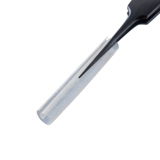nerve decompression procedures
Nerve compressions are one of the most common forms of nerve damage. Surgical management of nerve compressions are commonly performed to reduce pain and improve nerve function. However, poor outcomes following nerve decompression procedures have been linked to soft tissue attachments that can tether the nerve and result in the need for an additional surgical procedure.1,2
Although surgical decompression is successful in most cases, a significant number of patients (14%–19%) do not experience satisfactory results from the primary release alone.3 A revision procedure is often needed to alleviate the symptoms requiring a complete neurolysis in order to release the nerve from the compressive forces.4-6 Upon full release, a nerve wrap can be used to protect the nerve from soft tissue attachments.
The Axoguard Nerve Protector® is designed to reduce the potential for soft tissue attachments and nerve entrapment by remodeling into a new soft tissue layer.
remember the following:
- Axoguard Nerve Protector® remodels into a protective layer, similar to nerve epineurium, in 6 months.7
- In a series of 12 patients with recurrent cubital tunnel syndrome whose ulnar nerves were wrapped with Axoguard Nerve Protector®, there were significant improvements in post-operative pain, patient satisfaction, grip strength and pinch strength with no complications reported. In addition, 100% of patients improved.8
- In a 71-patient case series, Axoguard Nerve Protector demonstrated no safety concerns, and there were no reports of infection, persistent inflammation, or recurrent symptomatic perineural fibrosis.9
- Axoguard Nerve Protector is the most commonly used off-the-shelf option for peripheral nerve wraps in the U.S.10
solutions
 Axoguard Nerve Protector®
Axoguard Nerve Protector®  Axoguard HA+ Nerve Protector™ See sizing and IFU on solution pages
Axoguard HA+ Nerve Protector™ See sizing and IFU on solution pages more procedures
There’s only a short form between you and our nerve product team who can help you get more information about our nerve repair solutions.
references
- Stütz N, et al. Revision surgery after carpal tunnel release— Analysis of the pathology in 200 cases during a 2 year period. J Hand Surg Br. Feb 2006;31(1):68-71.
- Tung TH, et al. Secondary carpal tunnel surgery. Plast Reconstr Surg. Jun 2001;107(7):1830-1843.
- Haupt WF, et al. Long-term results of carpal tunnel decompression: assessment of 60 cases. J Hand Surg Br. Aug 1993;18(4):471-474.
- Strickland JW, et al. The hypothenar fat pad flap for management of recalcitrant carpal tunnel syndrome. J Hand Surg Am. Sept 1996;21(5):840-848.
- Varitimidis SE, et al. Recurrent compressive neuropathy of the median nerve at the wrist: treatment with autogenous saphenous vein wrapping. J Hand Surg Br. Jun 2000;25(3):271-275.
- Xu J, et al. The effect of wrapping scarred nerves with autogenous vein graft to treat recurrent chronic nerve compression. J Hand Surg Am. Jan 2000;25(1):93-103.
- Kokkalis ZT, et al. Assessment of processed porcine extracellular matrix as a protective barrier in a rabbit nerve wrap model. J Recon MicroSurg. Jan 2011;27(1):19-28.
- Papatheodorou, et al. Preliminary results of recurrent cubital tunnel syndrome treated with neurolysis and porcine extracellular matrix nerve wrap. J Hand Surg Am. May 2015;40(5):987-992.
- Jordaan PW, et al. Management of the scarred nerve using porcine submucosa extracellular matrix nerve wraps. J Musculoskelet Surg Res. Jan 2019; 3(1):128-133.
- Data on file.